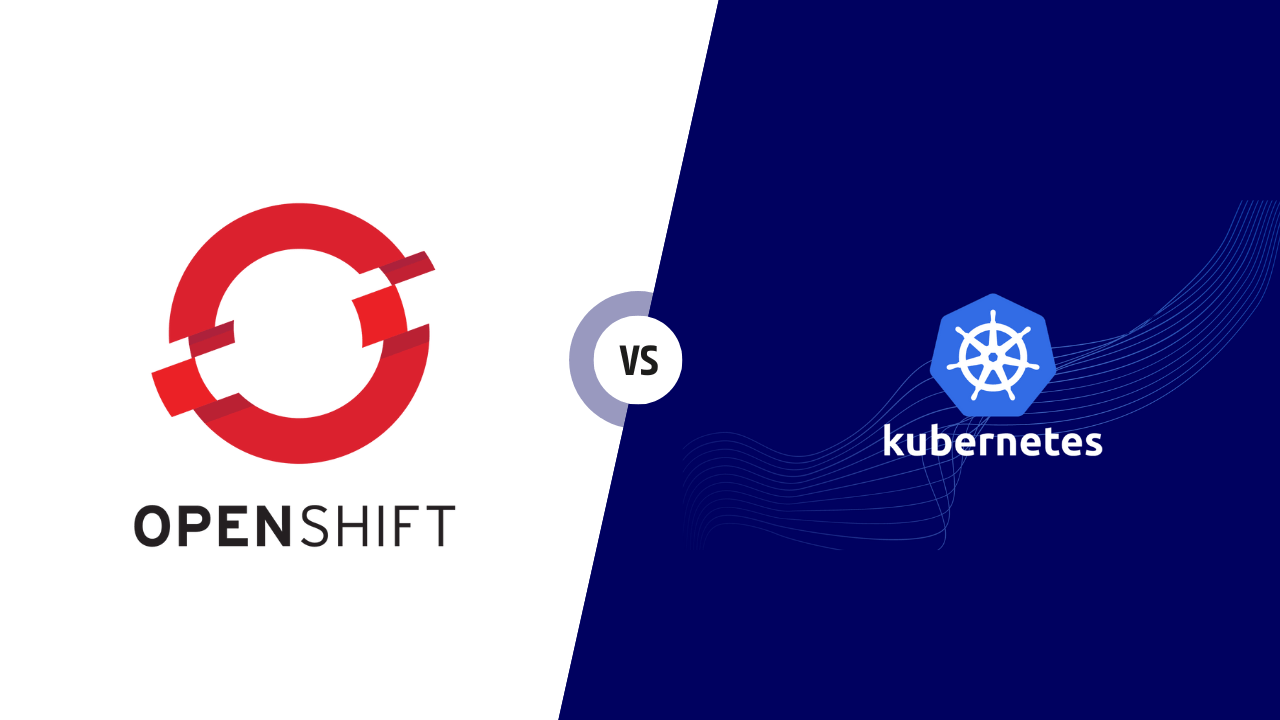Containerization has revolutionized the way applications are developed, deployed, and managed. It allows for greater scalability, flexibility, and efficiency in running software across different environments. Two of the most popular container orchestration platforms are OpenShift and Kubernetes.
Both OpenShift and Kubernetes offer similar benefits, such as automating container deployment, scaling, and management, as well as providing high availability and fault tolerance. However, there are some differences in terms of features, capabilities, and ease of use.
In this blog post, we will delve deeper into the core features and components of OpenShift vs Kubernetes, their architectures, and the advantages they offer for container orchestration. We will also compare and contrast the two platforms, exploring their key differences and use cases where each excels. This comparison will provide insights into choosing the right platform based on specific requirements and project goals.
Comparison Table OpenShift vs Kubernetes
| Feature | OpenShift | Kubernetes |
| Container Orchestration | Yes | Yes |
| Platform Provider | Red Hat | Cloud Native Computing Foundation (CNCF) |
| Installation | Easy, with OpenShift installer | Requires manual setup |
| Management | Robust management capabilities | Basic management functionalities |
| Scaling | Built-in scaling features | Scaling options available |
| Deployment | Automated deployment processes | Manual deployment processes |
| Security | Advanced security features | Basic security features |
| Access Control | Role-based access control (RBAC) | Role-based access control (RBAC) |
| Community Support | Supported by Red Hat community | Broad community support |
| Ecosystem | Integrated with Red Hat ecosystem | Broad ecosystem of tools and services |
| Use Cases | Enterprise deployments | General-purpose deployments |
Understanding OpenShift
OpenShift is a container platform developed by Red Hat, a leading provider of open-source solutions. It aims to provide a comprehensive platform for organizations to develop, deploy, and manage containerized applications efficiently.
OpenShift originated from Red Hat’s earlier Platform-as-a-Service (PaaS) offering called OpenShift Online, which was released in 2011. Over time, OpenShift evolved into a more robust and flexible platform that embraced containerization and adopted Kubernetes as its orchestration engine. Today, it is available as OpenShift Container Platform for on-premises deployments and OpenShift Dedicated for managed cloud environments.
Core features and components of OpenShift
OpenShift offers a rich set of features and components that enhance the Kubernetes experience. Some of the core features and components include:
- Container Runtime
- Build and Deployment Automation
- Integrated Developer Experience
- Image Registry
- Service Mesh
OpenShift supports multiple container runtimes, including Docker and CRI-O, providing flexibility in choosing the underlying technology.
OpenShift includes tools for automating the build and deployment processes, such as Source-to-Image (S2I) and Kubernetes-native build capabilities.
OpenShift provides developers with a user-friendly interface and tools for easy application development, testing, and collaboration.
OpenShift includes an integrated image registry to store and manage container images, allowing for versioning, security scanning, and efficient image distribution.
OpenShift integrates with popular service mesh solutions like Istio, enabling advanced traffic management, security, and observability for microservices architectures.
Overview of OpenShift’s architecture
OpenShift’s architecture is built on top of Kubernetes and extends it with additional components. At its core, OpenShift employs the same concepts of pods, services, and deployments as Kubernetes, but it introduces higher-level abstractions to simplify application management. These abstractions include Projects, Applications, and Routes.
OpenShift uses a master-node architecture where the master components handle the orchestration and management of the cluster, and the worker nodes execute the containers. The master components include the API server, controller manager, and scheduler, while the worker nodes host the pods and execute the containerized applications.
Advantages of using OpenShift for container orchestration
OpenShift provides an intuitive web-based console and command-line tools that simplify application development, testing, and collaboration, making it easier for developers to work with containers.
It’s integrated tools for build automation, deployment, and scaling help streamline operations and reduce manual effort, enabling faster application delivery. Also OpenShift offers built-in security features such as role-based access control (RBAC), image scanning, and network policies, ensuring secure container environments. It also helps organizations comply with regulatory requirements.
OpenShift leverages Kubernetes’ scaling capabilities to scale applications horizontally based on demand, ensuring high availability and efficient resource utilization.
OpenShift provides a robust platform for deploying and managing complex enterprise applications, enabling seamless scaling, fault tolerance, and easy integration with existing systems.
It’s automation capabilities, integrated tools, and container-based workflows make it an ideal platform for implementing DevOps practices and CI/CD pipelines.
Understanding Kubernetes
In 2014, Google released Kubernetes as an open-source project, allowing organizations to benefit from its container orchestration capabilities. Since then, Kubernetes has gained immense popularity and has become the industry standard for managing containers at scale.
Kubernetes offers a comprehensive set of features and components that enable efficient container orchestration. Some of the key features and components of Kubernetes include:
Pod
The basic building block of Kubernetes, a pod represents one or more containers that are tightly coupled and share the same resources, such as network and storage.
Service
Kubernetes services provide a stable network endpoint to access pods, allowing for load balancing and service discovery within the cluster.
Replication Controller/ReplicaSet
These components manage the desired number of pod replicas, ensuring high availability and fault tolerance by automatically scaling and replacing failed instances.
Deployment
Deployments provide declarative updates to pods and replica sets, enabling seamless rollouts and rollbacks of application changes.
Namespace
Kubernetes namespaces provide a logical separation and isolation of resources within a cluster, allowing multiple teams or projects to share the same cluster securely.
Overview of Kubernetes’ architecture
Kubernetes follows a master-worker architecture, where the master components manage and control the cluster, while the worker nodes execute the containers. The key components of the Kubernetes architecture include:
API Server: The central control point for managing and interacting with the cluster. It exposes the Kubernetes API, allowing users to control the cluster and its resources.
Controller Manager: This component ensures that the desired state of the cluster matches the actual state by monitoring and managing various controllers, such as the ReplicaSet controller and Deployment controller.
Scheduler: The scheduler assigns pods to worker nodes based on resource requirements, constraints, and availability, ensuring efficient utilization of cluster resources.
etcd: A distributed key-value store that stores the cluster’s configuration data, providing reliable data storage and consistency for the entire cluster.
Kubelet: The primary agent running on each worker node, responsible for managing and executing containers as part of pods.
Advantages of using Kubernetes for container orchestration
Kubernetes allows organizations to scale applications horizontally by adding or removing containers, ensuring high availability and efficient resource utilization. Kubernetes’ declarative approach to deployments enables seamless application rollouts and rollbacks, reducing the risk of errors during updates.
This project monitors the health of containers and automatically restarts or replaces failed instances, ensuring the continuous availability of applications. Kubernetes optimizes resource allocation, allowing multiple applications to run efficiently on a cluster while effectively managing resource utilization.
Kubernetes is cloud-agnostic, enabling applications to run consistently across different cloud providers or on-premises environments, promoting portability and avoiding vendor lock-in.
Use cases and industries where Kubernetes excels
It’s important to note that Kubernetes’ flexibility and scalability make it applicable to a wide range of industries and use cases.
As an example, let’s take a look at how GART implemented IoT device management using Kubernetes. They leveraged Kubernetes to effectively manage and scale their IoT edge devices. By utilizing Kubernetes, they achieved seamless deployment of containerized applications on edge devices, centralized management and monitoring of the devices, and streamlined software updates across their IoT network. For more details about their use case, you can visit the following link: IoT Device Management using Kubernetes.
Similarities between OpenShift and Kubernetes
- Container Orchestration
- Scalability and High Availability
- API-Driven Architecture
- Container Runtime Compatibility
Both OpenShift and Kubernetes excel in container orchestration, providing the ability to automate the deployment, scaling, and management of containerized applications.
Both platforms offer features for scaling applications horizontally, ensuring high availability and efficient resource utilization.
OpenShift and Kubernetes follow an API-driven approach, allowing users to interact with the platform and manage resources through a unified API.
Both OpenShift and Kubernetes support popular container runtimes such as Docker, allowing flexibility in choosing the underlying technology.
Key differences in features and capabilities: OpenShift vs Kubernetes
OpenShift provides additional features and tools beyond Kubernetes, including integrated build automation, image registry, service mesh integration, and a user-friendly developer interface.
OpenShift focuses on providing a more user-friendly experience with its web-based console and streamlined developer workflows, making it easier for developers to work with containers compared to Kubernetes.
OpenShift originated as a PaaS offering and retains some of its PaaS capabilities, providing higher-level abstractions and simplifications for application development and deployment.
Container management and orchestration capabilities
OpenShift builds upon Kubernetes and enhances its container management capabilities with additional tools and features tailored for enterprise environments.
Kubernetes provides a robust and extensible platform for container management and orchestration, offering a wide range of capabilities and a large ecosystem of tools and extensions.
Deployment and scaling options
OpenShift provides a user-friendly interface and integrated tools for automating the build and deployment process, allowing for easy application scaling and rollouts.
Kubernetes offers various deployment options, including Deployments and StatefulSets, enabling declarative updates and efficient scaling of applications.
Resource management and monitoring
OpenShift provides built-in monitoring capabilities, including logging, metrics, and health checks, allowing for effective resource management and troubleshooting.
Kubernetes offers resource management features, such as resource quotas and limits, enabling organizations to efficiently allocate and manage resources within the cluster.
User interface and ease of use
OpenShift focuses on providing a user-friendly web-based console and developer-friendly tools, making it easier for users to navigate and interact with the platform.
Kubernetes offers a command-line interface (CLI) and a web-based dashboard for managing and monitoring the cluster, but it may require a steeper learning curve compared to OpenShift.
Community support and ecosystem
OpenShift benefits from the strong community support of Kubernetes, as it is built upon Kubernetes. Additionally, OpenShift has its own active community and ecosystem, providing extensions, integrations, and support resources.
Kubernetes has a vast and active open-source community, with a wide range of tools, extensions, and documentation available. It enjoys broad industry adoption and has a mature ecosystem.
Conclusion: OpenShift vs Kubernetes
When comparing OpenShift vs Kubernetes, it’s important to consider your specific needs and requirements. OpenShift offers additional enterprise-focused features, while Kubernetes provides a robust foundation for container orchestration. Both platforms excel in their own ways, and the choice ultimately depends on factors such as scalability, ease of use, and integration capabilities. By understanding the similarities and differences between OpenShift and Kubernetes, you can make an informed decision that aligns with your container orchestration goals.









